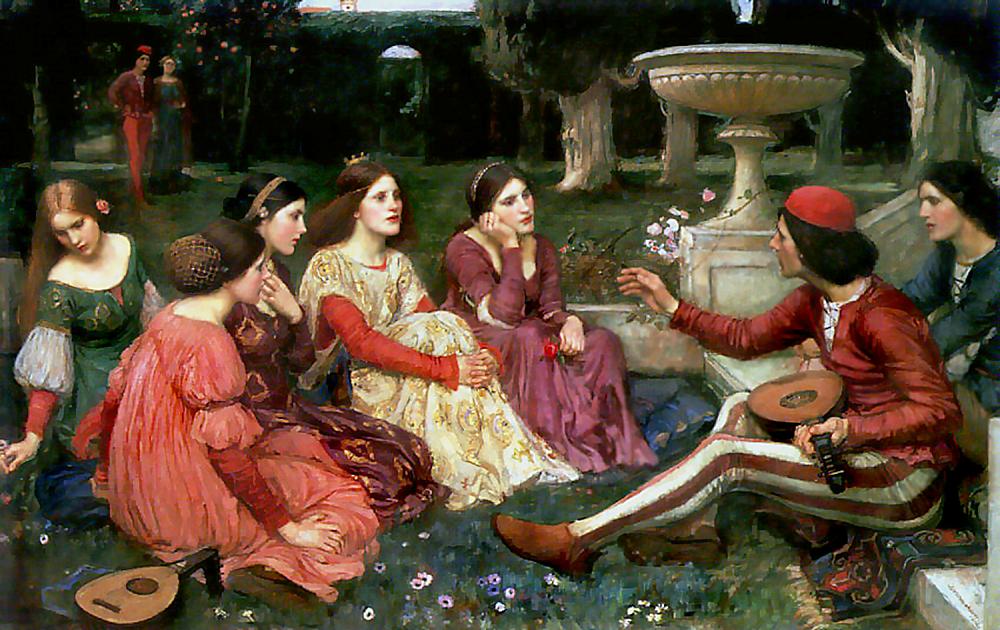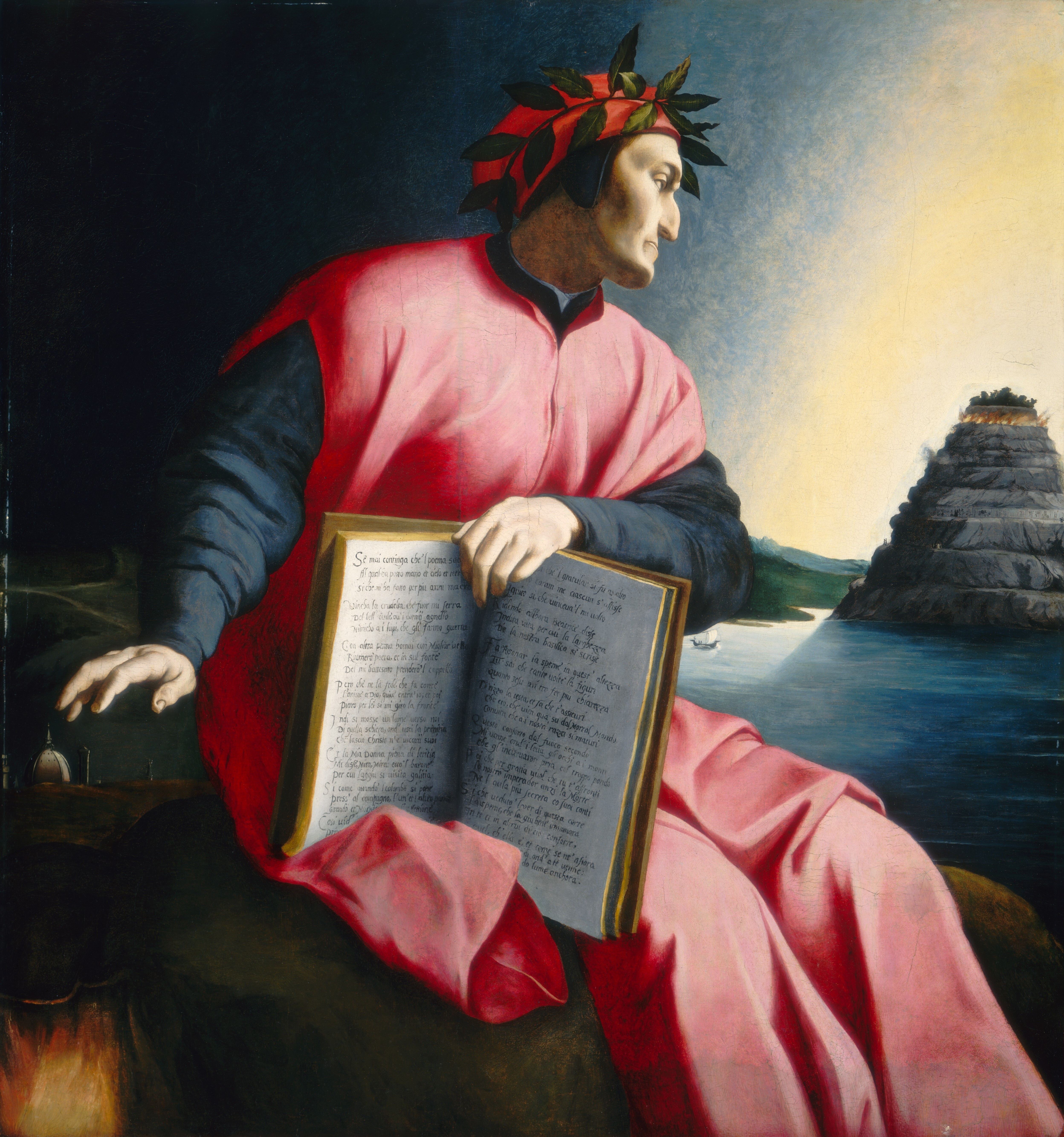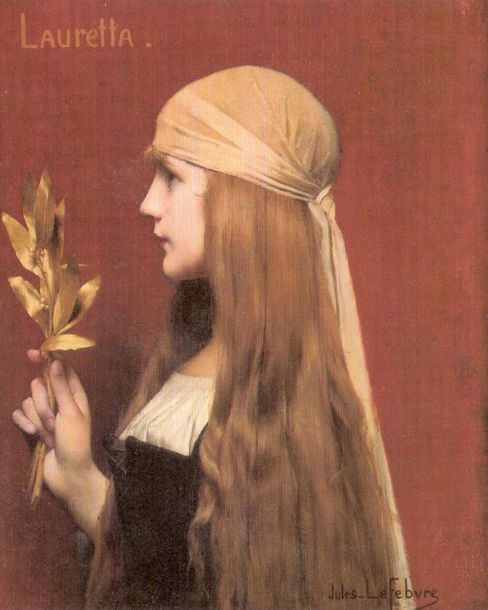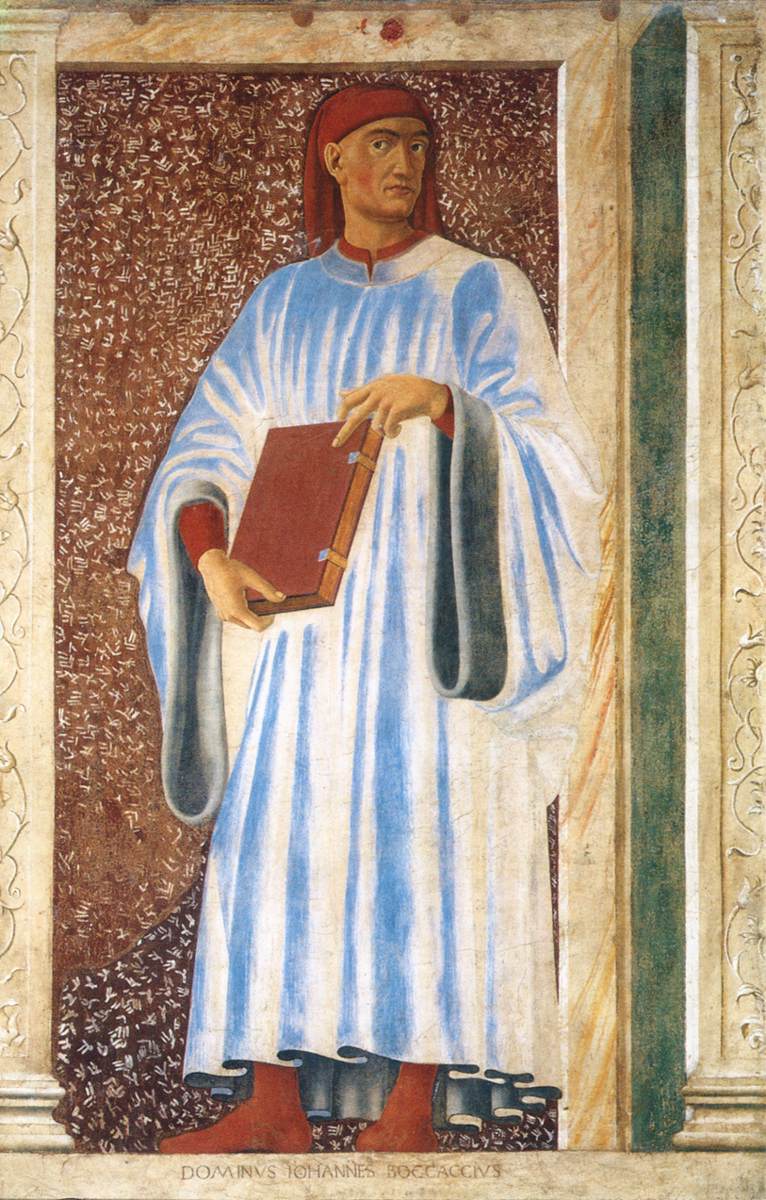|
The Monk's Tale
"The Monk's Tale" is one of the ''Canterbury Tales'' by Geoffrey Chaucer. The Monk's tale to the other pilgrims is a collection of 17 short stories, exempla, on the theme of tragedy. The tragic endings of these historical figures are recounted: Lucifer, Adam, Samson, Hercules, Nebuchadnezzar, Belshazzar, Zenobia, Pedro of Castile, Peter I of Cyprus, Bernabò Visconti, Ugolino of Pisa, Nero, Holofernes, Antiochus, Alexander the Great, Julius Caesar, and Croesus. Some literary critics believe that a large portion of the tale may have been written before the rest of the ''Canterbury Tales'' and that the four most contemporary figures were added at a later point. A likely dating for this hypothetical first draft of the text would be the 1370s, shortly after Chaucer returned from a trip to Italy, where he was exposed to Giovanni Boccaccio's '' Concerning the Falls of Illustrious Men'', as well as other works such as the '' Decameron''. The tragedy of Bernabò Visconti must ... [...More Info...] [...Related Items...] OR: [Wikipedia] [Google] [Baidu] |
Canterbury Tales
''The Canterbury Tales'' () is a collection of 24 stories written in Middle English by Geoffrey Chaucer between 1387 and 1400. The book presents the tales, which are mostly written in verse (poetry), verse, as part of a fictional storytelling contest held by a group of pilgrims travelling together from London to Canterbury to visit the shrine of Saint Thomas Becket at Canterbury Cathedral. The ''Tales'' are widely regarded as Chaucer's ''Masterpiece, magnum opus''. They had a major effect upon English literature and may have been responsible for the popularisation of the English vernacular in mainstream literature, as opposed to French language, French or Latin. English had, however, been used as a literary language centuries before Chaucer's time, and several of Chaucer's contemporaries—John Gower, William Langland, the Gawain Poet, and Julian of Norwich—also wrote major literary works in English. It is unclear to what extent Chaucer was seminal in this evolution of lite ... [...More Info...] [...Related Items...] OR: [Wikipedia] [Google] [Baidu] |
Antiochus IV Epiphanes
Antiochus IV Epiphanes ( 215 BC–November/December 164 BC) was king of the Seleucid Empire from 175 BC until his death in 164 BC. Notable events during Antiochus' reign include his near-conquest of Ptolemaic Egypt, his persecution of the Jews of Judea and Samaria, and the Maccabean Revolt, rebellion of the Jewish Maccabees. The son of List of Seleucid rulers, King Antiochus III the Great, Antiochus IV accession to the throne was controversial, as he was seen as a usurper by some. After the death of his brother Seleucus IV Philopator in 175 BC, the "true" heir should have been Seleucus's son Demetrius I Soter, Demetrius I. However, Demetrius I was very young and a hostage in Rome at the time, and Antiochus seized the opportunity to declare himself king instead, successfully rallying enough of the Greek ruling class in Antioch to support his claim. This helped set a destabilizing trend in the Seleucid Empire in subsequent generations, as an increasing number of claimants tried to u ... [...More Info...] [...Related Items...] OR: [Wikipedia] [Google] [Baidu] |
Crusade
The Crusades were a series of religious wars initiated, supported, and at times directed by the Papacy during the Middle Ages. The most prominent of these were the campaigns to the Holy Land aimed at reclaiming Jerusalem and its surrounding territories from Muslim rule. Beginning with the First Crusade, which culminated in the Siege of Jerusalem (1099), capture of Jerusalem in 1099, these expeditions spanned centuries and became a central aspect of European political, religious, and military history. In 1095, after a Byzantine request for aid,Helen J. Nicholson, ''The Crusades'', (Greenwood Publishing, 2004), 6. Pope Urban II proclaimed the first expedition at the Council of Clermont. He encouraged military support for List of Byzantine emperors, Byzantine emperor Alexios I Komnenos, AlexiosI Komnenos and called for an armed pilgrimage to Jerusalem. Across all social strata in Western Europe, there was an enthusiastic response. Participants came from all over Europe and had a ... [...More Info...] [...Related Items...] OR: [Wikipedia] [Google] [Baidu] |
Alexandria
Alexandria ( ; ) is the List of cities and towns in Egypt#Largest cities, second largest city in Egypt and the List of coastal settlements of the Mediterranean Sea, largest city on the Mediterranean coast. It lies at the western edge of the Nile Delta, Nile River delta. Founded in 331 BC by Alexander the Great, Alexandria grew rapidly and became a major centre of Hellenic civilisation, eventually replacing Memphis, Egypt, Memphis, in present-day Greater Cairo, as Egypt's capital. Called the "Bride of the Mediterranean" and "Pearl of the Mediterranean Coast" internationally, Alexandria is a popular tourist destination and an important industrial centre due to its natural gas and petroleum, oil pipeline transport, pipelines from Suez. The city extends about along the northern coast of Egypt and is the largest city on the Mediterranean, the List of cities and towns in Egypt#Largest cities, second-largest in Egypt (after Cairo), the List of largest cities in the Arab world, fourth- ... [...More Info...] [...Related Items...] OR: [Wikipedia] [Google] [Baidu] |
The Knight's Prologue And Tale
"The Knight's Tale" () is the first tale from Geoffrey Chaucer's ''The Canterbury Tales''. The Knight is described by Chaucer in the "General Prologue" as the person of highest social standing amongst the pilgrims, though his manners and clothes are unpretentious. We are told that he has taken part in some fifteen crusades in many countries and also fought for one pagan leader against another. Though the list of campaigns is real, his characterization is idealized. Most readers have taken Chaucer's description of him as "a verray, parfit gentil knyght" to be sincere but Terry Jones suggested that this description was ironic, and that Chaucer's readers would have deduced that the Knight was a mercenary. He is accompanied on his pilgrimage by the Squire, his 20-year-old son. The story introduces themes and arguments typically encountered in the literature of knighthood, including courtly love and ethical dilemmas. Sources and composition The epic poem ''Teseida'' (full title ' ... [...More Info...] [...Related Items...] OR: [Wikipedia] [Google] [Baidu] |
Divine Comedy
The ''Divine Comedy'' (, ) is an Italian narrative poetry, narrative poem by Dante Alighieri, begun and completed around 1321, shortly before the author's death. It is widely considered the pre-eminent work in Italian literature and one of the greatest works of Western literature. The poem's imaginative vision of the afterlife is representative of the medieval philosophy, medieval worldview as it existed in the Western Christianity, Western Church by the 14th century. It helped establish the Tuscan dialect, Tuscan language, in which it is written, as the standardized Italian language. It is divided into three parts: ''Inferno (Dante), Inferno'', ''Purgatorio'', and ''Paradiso (Dante), Paradiso''. The poem explores the condition of the soul following death and portrays a vision of divine justice, in which individuals receive appropriate punishment or reward based on their actions.Vallone, Aldo. "Commedia" (trans. Robin Treasure). In: Lansing (ed.), ''The Dante Encyclopedia'', ... [...More Info...] [...Related Items...] OR: [Wikipedia] [Google] [Baidu] |
Dante
Dante Alighieri (; most likely baptized Durante di Alighiero degli Alighieri; – September 14, 1321), widely known mononymously as Dante, was an Italian Italian poetry, poet, writer, and philosopher. His ''Divine Comedy'', originally called (modern Italian: ) and later christened by Giovanni Boccaccio, is widely considered one of the most important poems of the Middle Ages and the greatest literary work in the Italian language. Dante chose to write in the vernacular, specifically, his own Tuscan dialect, at a time when much literature was still written in Latin, which was accessible only to educated readers, and many of his fellow Italian poets wrote in French or Provençal dialect, Provençal. His ' (''On Eloquence in the Vernacular'') was one of the first scholarly defenses of the vernacular. His use of the Florentine dialect for works such as ''La Vita Nuova, The New Life'' (1295) and ''Divine Comedy'' helped establish the modern-day standardized Italian language. His wo ... [...More Info...] [...Related Items...] OR: [Wikipedia] [Google] [Baidu] |
Decameron
''The Decameron'' (; or ''Decamerone'' ), subtitled ''Prince Galehaut'' (Old ) and sometimes nicknamed ''l'Umana commedia'' ("the Human comedy", as it was Boccaccio that dubbed Dante Alighieri's ''Comedy'' "''Divine''"), is a collection of short stories by the 14th-century Italian author Giovanni Boccaccio (1313–1375). The book is structured as a frame story containing 100 tales told by a group of seven young women and three young men; they shelter in a secluded villa just outside Florence in order to escape the Black Death, which was afflicting the city. The epidemic is likely what Boccaccio used for the basis of the book which was thought to be written between 1348–1353. The various tales of love in ''The Decameron'' range from the erotic to the tragic. Tales of wit, practical jokes, and life lessons also contribute to the mosaic. In addition to its literary value and widespread influence (for example on Chaucer's ''Canterbury Tales''), it provides a document of lif ... [...More Info...] [...Related Items...] OR: [Wikipedia] [Google] [Baidu] |
De Casibus Virorum Illustrium
''De casibus virorum illustrium'' (''On the Fates of Famous Men'') is a work of 56 biographies in Latin prose composed by the Florentine poet Giovanni Boccaccio of Certaldo in the form of moral stories of the falls of famous people, similar to his work of 106 biographies ''De Mulieribus Claris''. Overview ''De casibus'' is an encyclopedia of historical biography and a part of the classical tradition of historiography. It deals with the fortunes and calamities of famous people starting with the biblical Adam, going to mythological and ancient people, then to people of Boccaccio's own time in the fourteenth century. The work was so successful it spawned what has been referred to as the ''De casibus'' tradition, influencing many other famous authors such as Geoffrey Chaucer, John Lydgate, and Laurent de Premierfait. De casibus also inspired character figures in works like ''The Canterbury Tales'', '' The Monk's Tale'', the ''Fall of Princes'' (c. 1438), ''Des cas de nobles hommes ... [...More Info...] [...Related Items...] OR: [Wikipedia] [Google] [Baidu] |
Giovanni Boccaccio
Giovanni Boccaccio ( , ; ; 16 June 1313 – 21 December 1375) was an Italian people, Italian writer, poet, correspondent of Petrarch, and an important Renaissance humanism, Renaissance humanist. Born in the town of Certaldo, he became so well known as a writer that he was sometimes simply known as "the Certaldese" and one of the most important figures in the European literary panorama of the 14th century, fourteenth century. Some scholars (including Vittore Branca) define him as the greatest European prose writer of his time, a versatile writer who amalgamated different literary trends and genres, making them converge in original works, thanks to a creative activity exercised under the banner of experimentalism. His most notable works are ''The Decameron'', a collection of short stories, and ''De Mulieribus Claris, On Famous Women''. ''The Decameron'' became a determining element for the Italian literary tradition, especially after Pietro Bembo elevated the Boccaccian styl ... [...More Info...] [...Related Items...] OR: [Wikipedia] [Google] [Baidu] |
Italy
Italy, officially the Italian Republic, is a country in Southern Europe, Southern and Western Europe, Western Europe. It consists of Italian Peninsula, a peninsula that extends into the Mediterranean Sea, with the Alps on its northern land border, as well as List of islands of Italy, nearly 800 islands, notably Sicily and Sardinia. Italy shares land borders with France to the west; Switzerland and Austria to the north; Slovenia to the east; and the two enclaves of Vatican City and San Marino. It is the List of European countries by area, tenth-largest country in Europe by area, covering , and the third-most populous member state of the European Union, with nearly 59 million inhabitants. Italy's capital and List of cities in Italy, largest city is Rome; other major cities include Milan, Naples, Turin, Palermo, Bologna, Florence, Genoa, and Venice. The history of Italy goes back to numerous List of ancient peoples of Italy, Italic peoples—notably including the ancient Romans, ... [...More Info...] [...Related Items...] OR: [Wikipedia] [Google] [Baidu] |
The Monk - Ellesmere Chaucer
''The'' is a grammatical article in English, denoting nouns that are already or about to be mentioned, under discussion, implied or otherwise presumed familiar to listeners, readers, or speakers. It is the definite article in English. ''The'' is the most frequently used word in the English language; studies and analyses of texts have found it to account for seven percent of all printed English-language words. It is derived from gendered articles in Old English which combined in Middle English and now has a single form used with nouns of any gender. The word can be used with both singular and plural nouns, and with a noun that starts with any letter. This is different from many other languages, which have different forms of the definite article for different genders or numbers. Pronunciation In most dialects, "the" is pronounced as (with the voiced dental fricative followed by a schwa) when followed by a consonant sound, and as (homophone of the archaic pronoun ''thee' ... [...More Info...] [...Related Items...] OR: [Wikipedia] [Google] [Baidu] |





